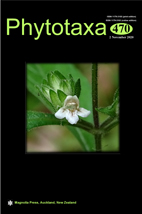Abstract
Phyllagathis phamhoangii, a species from Vietnam, was originally described in Phyllagathis based on its resemblance to P. nanakorniana and P. subrotunda in habit, rhizome morphology and leaf shape. However, its overall morphology, mainly stamen and capsule morphology, corresponds better with Fordiophyton indicating questionable generic affiliation. We included molecular (nrITS) and anatomical (crystal form) evidences to resolve the generic affiliation of P. phamhoangii. Our phylogenetic analyses recovered P. phamhoangii inside Fordiophyton and P. nanakorniana and P. subrotunda inside the Kerriothyrsus clade. The Fordiophyton clade is characterized by the presence of raphides, while the Kerriothyrsus clade is characterized by druses. Based on these evidences, P. phamhoangii is herein transferred to Fordiophyton, resulting in a new combination F. phamhoangii. It is morphologically similar to F. peperomiifolium but differs from the latter in the leaf blade with shortly acuminate to acuminate apex (vs. broadly acute), hypanthium 4-ridged (vs. not ridged), and connectives of shorter stamens dorsally spurred (vs. not spurred).

